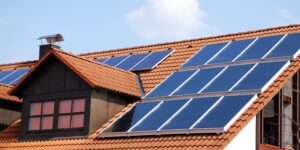What we mean when we talk about “green buildings” is structures that are constructed and designed in a way that causes as little harm to the ecosystem and the people who live or work inside them as possible. A healthy indoor climate is maintained through the use of sustainable materials, the installation of energy-efficient systems, the reduction of waste and pollution, and so on. An environmentally friendly structure is one that uses as few resources as possible without sacrificing comfort or safety for its occupants. Sustainable, energy-efficient, and socially helpful design and construction practices are the hallmarks of green buildings, which take into account all phases of a structure’s existence.
Benefits of Building Green
Among the many advantages of eco-friendly construction are:
Green buildings are beneficial to the ecosystem because they are created to use as little energy, water, and waste products as possible. By relying less on fossil fuels, they contribute to the fight against climate change, and renewable energy sources like solar and wind power are used to power the structure. Features like rainwater collection and graywater recycling are common in green buildings because they help preserve water.

The bottom line can profit greatly from going the eco-friendly route, as even if the construction costs are higher at the outset, they will be much lower in the long run. Greener structures use less power to function, which means they cost less to heat and cool. Since green products and systems tend to be more long-lasting than their conventional counterparts, they also require less upkeep. Sustainable design elements can also increase the value of a structure after it has been sold.
The use of non-toxic materials, enhancement of interior air quality, and reduction of allergens and other harmful substances all contribute to a healthier living atmosphere for building occupants, making green buildings a good choice. Natural lighting and ventilation are two of the many green construction features shown to boost morale and output.
When considering the long-term value of a structure, it is important to consider the impact on the environment as well as the well-being of the people who will be living or working there.
How Building Green Reduces Home Repair Costs
In a number of ways, green construction can greatly cut the cost of home maintenance:
Construction with long-lasting and eco-friendly elements is a hallmark of green structures. Stronger and more durable than traditional timber, recycled steel, concrete, and wood composites can extend the life of a structure and cut down on maintenance costs.
High-efficiency heating and cooling systems, insulation, and energy-saving appliances are all standard in green structures. Less energy is used to run the building, meaning reduced utility bills and less wear and tear on the building’s systems.
Materials used in green construction tend to last longer than their conventional counterparts because they are impervious to the sorts of wear and tear brought on by moisture, insects, and other natural factors. Metal roofing, as opposed to asphalt tiles, can better withstand the elements, such as high winds and large hail.
Quality of indoor air is enhanced by the use of non-toxic and low-emission materials, which is one way in which green structures help those with respiratory issues. Repair costs that arise from mold, mildew, and other IAQ problems can be mitigated through heightened attention to maintaining a healthy interior environment.
Green construction helps homeowners save money in the long term because it reduces the number of times things need fixing. Sustainable materials and energy-efficient systems can lessen the building’s negative effects on the ecosystem, making it a more ethical and sustainable option for homeowners.
Challenge of Building Green

Green construction has many advantages, but there are also some difficulties that residents may encounter.
Green development may require additional funding up front when compared to more conventional building practices. However, the savings on electricity bills and upkeep costs in the long run can more than make up for the initial investment.
Depending on where you live, you may have a harder time locating or a smaller selection of sustainable products. In order to find these supplies, homeowners may need to do more investigation or hire specialist contractors.
To ensure conformity with applicable building codes and regulations, green construction may necessitate extra permits and inspections. This may increase the overall project budget and timeline.
Because of a lack of information and instruction, many homeowners may be unaware of the advantages of green construction and may not know where to begin. Homeowners can learn more about the advantages of green building and find tools to get started if there is an educational and awareness campaign to spread the word.
While there are undoubtedly some drawbacks to ecological construction, the advantages often make up for them. Homeowners can surmount these challenges and create a sustainable, healthy living environment by working with seasoned contractors and conducting appropriate research.
In sum, there are many positive outcomes for homeowners from eco-friendly construction practices, including lower energy expenses, better indoor air quality, and fewer maintenance headaches. Homeowners can create a more eco-friendly and socially helpful living space by using energy-efficient systems and sustainable materials. Higher initial costs and material availability are two potential obstacles to constructing sustainably, but these issues can be overcome with proper planning, research, and the help of knowledgeable contractors. In the end, building green benefits both homeowners and the ecosystem by creating a healthier and more long-lasting home for future generations. Homeowners should think about the long-term when deciding whether or not to construct green.
